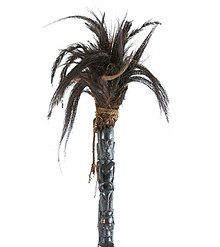
A tunggal panaluan is a magic staff used by shamans of the Batak people, who live in the highlands of North Sumatra, Indonesia. Traditionally the tunggal panaluan is made from wood of a specific tree and carved with human figures and embellished with horsehair and cooked human brain, both procured from sacrificial victims.
